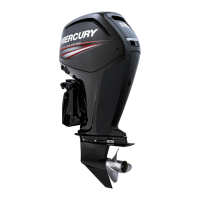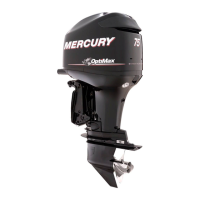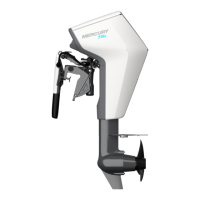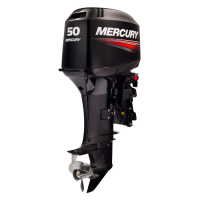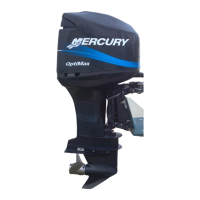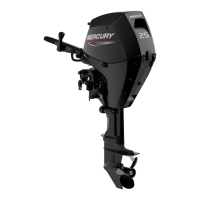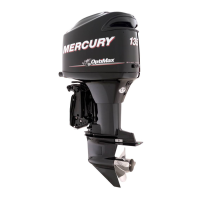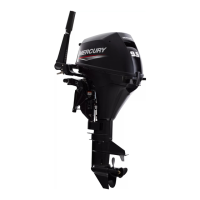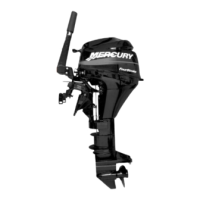Why is the DVA reading low on my Mercury 75 Outboard Motor?
- RRandy RiveraJul 25, 2025
If the DVA reading is low, the stator, adapter module, or switch box may be defective. To isolate the problem, refer to the particular engine model procedure.
Why is the DVA reading low on my Mercury 75 Outboard Motor?
If the DVA reading is low, the stator, adapter module, or switch box may be defective. To isolate the problem, refer to the particular engine model procedure.
What does it mean if the DVA is normal after disconnecting the BLUE adapter lead on my Mercury Outboard Motor?
If the DVA reading is normal (190 to 260 volts) after disconnecting the BLUE adapter lead from the switch box and cranking the engine, the switch box is defective.
What does it mean if the DVA is normal after disconnecting the BLUE/WHITE adapter lead on my Mercury Outboard Motor?
If the DVA reading is normal (190 to 260 volts) after disconnecting the BLUE/WHITE adapter lead from the switch box and cranking the engine, the switch box is defective.
What to do if DVA readings are still low after cranking the Mercury 75?
If DVA readings are still low after cranking the engine, either the stator or the adaptor is defective. Disconnect the GREEN/WHITE and WHITE/GREEN stator leads from the adapter.
What to do if the DVA reading is still low after cranking the Mercury 75 Outboard Motor?
If the DVA reading is still low after cranking the engine, either the stator or the adapter is defective. Disconnect the GREEN/WHITE and WHITE/GREEN stator leads from the adapter.
What does it mean if resistance between stator leads is normal on a Mercury Outboard Motor?
If the resistance between the GREEN/WHITE and WHITE/GREEN stator leads is normal (660 to 710 ohms), the adapter is defective.
What does it mean if resistance between stator leads is incorrect on a Mercury 75 Outboard Motor?
If the resistance between the GREEN/WHITE and WHITE/GREEN stator leads is incorrect, the stator is defective.
Details on outboard emissions compliance with US Environmental Protection Agency standards.
Guidance on matching outboard horsepower to boat capacity to prevent damage or injury.
How to choose the correct propeller for optimal boat performance and engine operation.
Explains the function and importance of the safety lanyard stop switch for engine shutdown.
Technical specifications for different outboard models including horsepower, RPM, and dimensions.
Diagrams and labels identifying key external parts of the outboard engine.
Guidelines on selecting the correct type and octane rating of gasoline for engine operation.
Information on components that can restrict fuel flow and potentially damage the engine.
Specifies the recommended type of oil for the outboard engine's lubrication system.
Step-by-step instructions for refilling the engine's oil injection system reservoir.
Explanation of the outboard's power trim and tilt system for adjusting operating position.
Details on how to operate the power trim system, including potential control hazards.
Instructions on adjusting trim tabs to compensate for steering torque and improve boat handling.
Essential checks to perform before starting the outboard engine for safe operation.
Procedures for the initial break-in period to ensure engine longevity and performance.
Step-by-step guide for safely starting the outboard engine.
Instructions on how to properly shift the outboard between forward, neutral, and reverse gears.
Specific operating instructions and handling characteristics for jet drive models.
A comprehensive schedule outlining routine inspections and maintenance tasks for the outboard.
How to flush the outboard's cooling system with fresh water after use in salt or polluted water.
Procedures for inspecting and replacing fuel system components like filters and lines.
Guidelines for inspecting the battery to ensure reliable engine starting capability.
Steps for inspecting, checking the gap, and replacing spark plugs for optimal engine performance.
Instructions on how to check, drain, refill, and lubricate the outboard's gearcase.
Advice on returning the outboard to an authorized dealer for factory-trained service.
Steps to take if you encounter an issue with your Mercury product and need assistance.
Lists possible causes and solutions when the starter motor fails to engage the engine.
Identifies common reasons why the engine may not start and how to address them.
Explains potential causes for inconsistent engine operation and troubleshooting steps.
Diagnoses and solutions for reduced engine performance, including propeller and load issues.
Specific troubleshooting for jet drive models, covering performance and overspeed issues.
Information on using Mercury-approved fasteners and following instructions for secure engine mounting.
Guidance on setting the correct mounting height for optimal performance and avoiding issues.
Detailed steps and torque specifications for securely attaching the outboard to the boat transom.
Instructions for routing and connecting various hoses, wiring, and control cables to the engine.
Procedures for installing and adjusting the shift cable for proper gear engagement.
Steps for filling the oil tank and priming the oil injection pump before initial engine start.
| Horsepower | 75 hp |
|---|---|
| Starting | Electric |
| Cylinders | 3 |
| Warranty | 3 years |
| Shaft Length | 20 in. or 25 in. |
